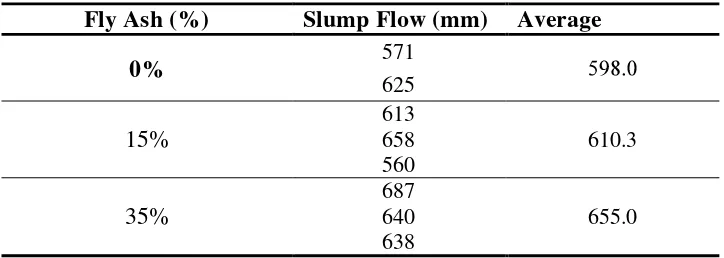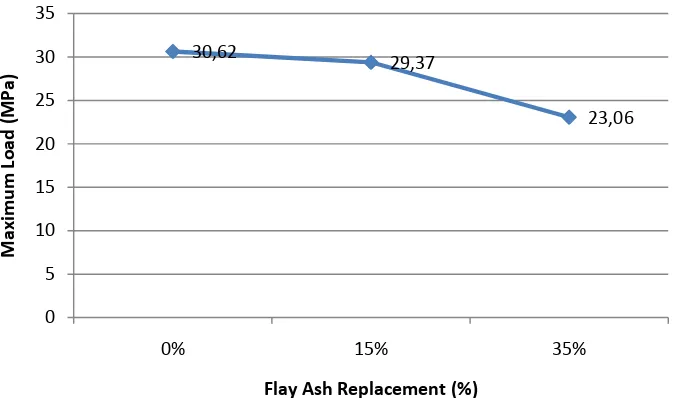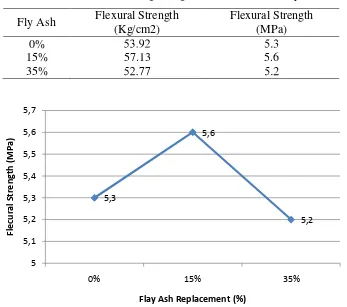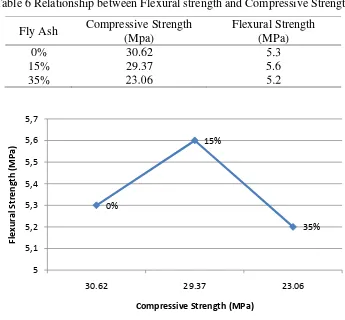MECHANICAL PROPERTIES OF SELF COMPACTING
CONCRETE USING FLY ASH
PUBLICATION ARTICLE
Arranged By:
Khaled Omar Mohamed Oraibi S100130014
POSTGRADUATE PROGRAM
DEPARTMENT OF CIVIL ENGINEERING
MUHAMMADIYAH UNIVERSITY SURAKARTA
MECHANICAL PROPERTIES OF SELF COMPACTING
CONCRETE USING FLY ASH
Khaled Omar Mohamed Oraibi 1) Mohamad Solikin 2) Yenny Nurchasanah 3) Student, Postgraduate Civil Engineering Program Muhammadiyah University of Surakarta (2014-2015), Jl. A. Yani Tromol Pos I Pabelan Surakarta 57102; Telp. 0271-730772 Indonesia
Email: [email protected]
Abstract The purposes of this study were 1) to analyze the effect of fly ash on the mechanical properties of self compacting concrete; and 2) to determine the optimum fly ash content as cement replacement in improving mechanical properties on self compacting concrete at 28 days. This research was conducted in laboratory of Muhammadiyah University Surakarta. Primary and secondary data collection techniques were used in this research experiment. Primary data was collected directly form laboratory experiments. All the data was recorded on a daily basis until the research is completed. The researcher collected the data from the result of self-compacting concrete and compare to other standards to get the level of compressive strength and tensile strength. Self- Compacting Concrete is characterized by filling ability, passing ability and resistance tosegregation. Mechanical properties of self-compacting concrete modified with 0%, 15% and 35% Fly ash as cement replacement were studied. The main goal were to analyses mechanical properties (compressive strength, flexural strength and modulus of elasticity) of self-compacting concrete mix and to determine the optimum amount for Fly Ash replacement for improved mechanical properties. From the study results can be concluded that 1) the Slump Flow test results were increasing as the amount of Fly Ash increased within the allowable ranges of 500-700 mm in accordance to ASTM standard; 2) the compressive strength and modulus of elasticity measurement values decreased as the amount of fly ash increased from 0 to 35% whereas; and 3) the value for improved mechanical property of flexural strength was found at 15% Fly ash content.
Keyword: fly ash, Self-Compacting Concrete
I. INTRODUCTION
Self-Compacting Concrete (SCC), which flows under its own weight and does not require
any external vibration for compaction, has revolutionized concrete placement. SCC, was first
introduced in the late 1980’s by Japanese researchers, is highly workable concrete that can flow
under its own weight through restricted sections without segregation and bleeding. Such concrete
should have a relatively low yield value to ensure high flow ability, a moderate viscosity to resist
segregation and bleeding, and must maintain its homogeneity during transportation, placing and
curing to ensure adequate structural performance and long term durability. The successful
development of SCC must ensure a good balance between deformability and stability.
Self-compacting concrete can applied in narrow area because of self-compacting concrete
(SCC) does not requires vibration for placing and compaction. It is able to flow under its own
weight, completely filling formwork and achieving full compaction, even in the presence of
congested reinforcement. The hardened concrete is dense, homogeneous and has the same
As coal is burned in a power plant or industrial boiler, its noncombustible mineral content
(ash) is partitioned into bottom ash (or slag), which remains in the furnace, and fly ash, which
rises with flue gases. Bottom ash is easy to collect since it is removed during routine cleaning of
the boilers. The properties of bottom ash make it a good road base and construction material, and,
as such, it can be readily given away or sold. Fly ash, on the other hand, is not so easily disposed
of. Most fly ash is captured by pollution control devices before release to the atmosphere
(Daniels et al., 2002).
The use of fly ash as a material for self-compacting concrete is very beneficial because
the use of fly ash reduces permeability, bleeding, water demand and the heat of hydration. It also
improves workability, however strength development is slower. For every ton of cement that is a
manufactured, approximately one ton of carbon dioxide gas, the main greenhouse gas, is released
into the environment. From an environmental perspective, one of the benefits of fly ash is that the
replacement of large portions of cement with fly ash serves to reduce CO2 emissions, thus
making concrete an even greener material.
To enhance the properties of fresh and harden concrete, the addition of fly ash can be used
as partial replacement of cement. Then, the use of fly ash in concrete is very beneficial because it
is not only economical from cost but it also improves the fresh and hardened properties of
concrete. Usually, the addition of fly ash is about 10-35% replacement to the cement can helps to
maintain the viscosity of concrete resulting to in blockage risk and decreases the superplasticizer
requirements.
II. LITERATURE REVIEW
Self-compacting concrete is one of innovative concrete by managing a fluid mixture
which can reduce the amount of cementitious materials and total volume of concrete required. In
Self-compacting concrete, the fluid mixture can flow under its own weight, completely filling
formwork and achieving full compaction in structures even with congested reinforcement. Then,
the use of Self-compacting concrete also can increases the speed of construction and reduces
noise. Moreover, in terms of Self-compacting concrete, the cost can be reduced by replacing a
part of the Portland cement, especially if the mineral admixtures are waste or industrial
by-product such as fly ash. Fly ash is a by-by-product of the combustion of pulverized coal in thermal
power plants. Therefore use of fly ash not only provides economical benefits but also reduces
heat of hydration Henceforth replacing of Portland cement with fly ash can reduce the production
of CO2 (Asha et al, 2013). Self-compacting concrete (SCC) is a fluid mixture, which is suitable
for placing in difficult conditions and in structures with congested reinforcement, without
Fly Ash is a pozzolanic cement replacement that enhances the performance of concrete by
increasing compressive strength, improving workability, durability, long term strength, resistance
to freeze-thaw damage and reduces permeability, efflorescence shrinkage, thermal cracking,
alkali silica reaction and sulfate attack in concrete. Basically using fly ash makes better concrete
that is more economical and better for the environment.
Fly ash is one of the most extensively used by-product materials. It is an inorganic,
noncombustible, finely divided residue collected or precipitated from the exhaust gases of any
industrial furnace. Most of the fly ash particles are solid spheres and some particles, called
cenospheres, are hollow. Also present are plerospheres, which are spheres containing smaller
spheres inside. The particle sizes in fly ash vary from less than 1 μm to more than 100 μm with
the typical particle size measuring less than 20 μm. Their surface area is typically 300 to 500 m2/kg, although some fly ashes can have surface areas as low as 200 m2/kg and as high as 700
m2/kg. Fly ash is primarily silicate glass containing silica, alumina, iron, and calcium. The
relative density or specific gravity of fly ash generally ranges between 1.9 and 2.8 and the color is
generally gray or tans (Venkataraju, 2011).
Fly ash improves concrete workability and lower water demand. This is because fly ash
pozzoland becomes denser, stronger and generally more durable long terms compared to straight
Portland Cement Concrete mixture. Fly ash particles are spherical and have the same size with
Portland cement, therefore the need of water is lower for mixing and placing concrete can be
obtained.
The reduction in water leads to improved strength. Because some fly ash contains larger
or less reactive particles than portland cement, significant hydration can continue for six months
or longer, leading to much higher ultimate strength than concrete without fly ash.
Fly ash can reduce the permeability and absorption of concrete. By reducing the
permeability of chloride ion ingress, corrosion of embedded steel is greatly decreased. Also,
chemical resistance is improved by the reduction of permeability and adsorption. Fly ash is
economical because fly ash can substitute Portland cement in concrete mixture and the mixture
with fly ash can increase long term strength and durability.
III. RESEARCH METHODOLOGY Material
Portland cement concrete is the popular material used in civil engineering projects around
many types of construction in which it is used, and the minimal maintenance requirements during
service.
Generally, aggregates take 70% to 80% of the volume of concrete and have an important
influence on its properties. They are granular materials, from natural rock (crushed stone, or
natural gravels) and sands. In addition to their use as economical filler, aggregates generally
provide concrete with better dimensional stability and wear resistance. Although aggregate
strength can play sometimes an important role, for example in high-strength concretes, for most
applications the strength of concrete and mix design are essentially independent of the
composition of aggregates.
Fly Ash is a pozzolan that reacts with available lime in cement providing more
cementitious compounds and is a direct replacement for cement. Fly ash replacement is
conducted on a mass basis. Fly ash replacements of 0%, 15%, and 35% will be used.Fly ash that
was used for this research is class F fly ash.
Mixed Design
A total of six concrete mixes was tested. The mixes are prepared byvarying the
water/binder ratio (w/b) while keeping the paste volume constantand gravel/total aggregate
ratioconstant. W/c ratios of 0.47are used. Fly ash replacement is conducted on a mass basis. Fly
ash replacements of 0%, 15%, and 35% are tested.
Table 1 Concrete Mix Proportion
The analysis is conducted after the testing of a specimen by comparing and analyzing the
data obtained. The tests that performed are compressive test and modulus of elasticity. The data
that resulted from those tests were assessed and investigate about the result. After knowing the
data result of each test, then the analysis is conducted and inserts it into the table or graph so it
can be seen easily and know the differences of each composition. Finally, Conclusion is drawn.
IV. RESULT AND DISCUSSION 1. Slump Flow Test
Slump Flow was used for providing information on filling ability (flowability) and
passing ability (for a stable mix, high flowability tracks with passing ability).The slump flow test
used to evaluate the deformation capacity of concrete under its own weight without external
forces against the friction of the plate. Slump flow diameter of (500 – 700mm)was measured to
the concrete flowing over a level plate after a slump cone is lifted. The test was conducted in
accordance to ASTM C 1611.
Table 2 Slump flow test result
Fly Ash (%) Slump Flow (mm) Average
0% 571
625
15%
613
610.3 658
560
35%
687
655.0 640
638
The slump flow test was conducted in according to ASTM C 1611. The test is used to
assess the horizontal free flow of SCC in the absence of obstructions. On lifting the slump cone,
filled with concrete, the concrete flows. The average diameter of the concrete circle is a measure
for the filling ability of the concrete.
The Slump flow was calculated using Eq. 1:
Slump Flow:
2 ) (d1 d2
Where:
d1= the largest diameter of circular spread of the concrete, and
d2= the circular spread of the concrete at an angle approximately perpendicular to d1
The observed result for slump test was increased as the fly ash % replacement increased.
Kamran and Mishra (2014) reported similar trend on increasing the slump flow as the Fly Ash %
replacement increased. Also Vageesh and Reena (2014) and Ali (2014) reported the similar trend
Figure 1 Slump flow result
2. Compressive Strength test
Compressive Strength Test is used to determine the resistance to permanent deformation
of normal and modified self-compacting mixtures (RILEM, 2014). Cubes were used to determine
compressive strength of SCC. It was conducted by applying a static load to a specimen and then
measuring the maximum load. Experimental objects testing is done using UTM (Universal
Testing Machine) to obtainthe maximum loadby the unit KN, and then the maximum load press
is made to the calculation unit MPa. The compressive strength test is by far the most popular
method of shear testing because it is one of the fastest and cheapest methods of measuring shear
strength.
Table 3 Compressive strength measured at 28 days
Fly Ash (%) Compressive
control concrete to MPa and MPa at 15% and 35% fly ash replacement respectively
Figure 2 Compressive strength test result of SCC with different percent Fly Ash
The compressive strength test is affected by percentage of fly ash. From the Figure 2 it is
clear that there are differences on compressive strength test among all self-compacting concrete
mixtures. As shown in figure 2 self-compacting concrete 0% Fly Ash has the highest compressive
strength value followed by SCC modified with 15%, 35%. Similarly Ganeshwaran et al. (2012)
reported that compressive strength decreased with the increase in replacement of cement by fly
ash.
Fly ash as filler can fill cavities in the concrete so that the concrete mix to more solid and
strong, but the greater the level of fly ash will lower the value of the slump. This happens because
the fly ash absorb more water when compared with cement, so that the mixture becomes drier
which subsequently affect slump concrete value becomes lower with increasing levels of fly ash
used (Pujianto, A., 2010). The greater the levels of fly ash, the water content needed is also
increasing, so this affects the value of FAS which resulted in concrete compressive strength
decreased while passing through the fly ash content of 15%.
Ankush (2014) investigate the effect of fly ash replacing cement on compressive strength
and concluded that an increase fly ash from 10% to 50% decreased compressive strength value
from 53.17MPa to 39.25 MPa for 28 days of curing time. Mohamed (2011) reported that higher
amount of fly ash had higher values of compressive strength until 30 % of fly ash. However, after
the optimum amount of Fly Ash, the increase in Fly Ash decreased the compressive strength of
self-compacting concrete. The reason why there is difference in optimum percentage of Fly Ash
from the current research is that due to mix design variation in which the amount of cement used
in research by Mohamed (2011) is 550 kg/m3 with W/C of 0.42 whereas in this research it is 440
3. Modulus of Elasticity
The modulus of elasticity (MOE) (Young’s modulus) E is a material property, that describes its stiffness. Mechanical deformation puts energy into a material. The energy is stored
elastically or dissipated plastically. To this study strength for modulus were determined at 28 day
of specimens curing as per ASTM C 469. Three concrete cylinders were prepared with
dimensions of 150 mm x 300mm were molded and cured in accordance to standard description.
The concrete were subjected to a slowly increasing longitudinal compressive stress and
readings were recorded and MOE were computed and beside it for comparison the modulus was
also calculated using the formula and all result shown in table 4.
Table 4. Modulus of Elasticity (MOE) at 28 days as ASTM C 469
Fly Ash Modulus of
highest modulus of elasticity value of 36.9 GPa. Similarly, Turk and Karatas (2011) reported that
modulus of elasticity of self- compacting concrete decreased with an increase in fly ash content
as replacement for cement.
Figure 3 Modulus of elasticity test result of SCC with different percent Fly Ash
4. Flexural Strength
Flexural test measures the force required to bend a beam under three point loading
conditions, its data often used to select materials for parts that will support loads against bending
load. Flexural modulus is used as an indication of a material’s stiffness. This test was done as specified by the ASTM D-790 and ASTM C 78 methods and procedures. The results are
presented in table 5. The dimension of the specimens was made in consideration of the size of
coarse aggregate 19 mm (20 mm).
Table 5. Flexural Strength (Kg/cm2 or MPa) at 28 days
Fly Ash Flexural Strength
Figure 4. Flexural strength test result of SCC with different percent Fly Ash
The Flexural strength value is affected by percentage of fly ash. From the Figure 4 it is
clear that there are differences on Flexural strength test among all self-compacting concrete
mixtures. As shown in figure 4.10 self-compacting concrete 15% Fly Ash has the highest
Flexural strength value followed by SCC modified with 0%, 35%. In general the flexural strength
observed to decrease as the amount of Fly Ash replacement was increased to 35%. The optimum
value for flexural strength with Fly Ash replacement recorded at 15% as shown in figure 4.10.
Vageesh and Reena (2014) reported the similar trend on flexural strength decrease as the Fly Ash
% replacement increased to 30% as compared to 10% and 20% the optimum flexural strength
was observed at 10% Fly Ash replacement at 28 days. In addition Gaywala and Raijiwala (2011)
Relationship between Flexural strength and Compressive Strength
The Flexural strength test is affected by percentage of fly ash. From the test carried out
show that compressive strength and flexural strength for control mix (CM) at 28 days were
30.62MPa and MPa respectively. On the other side as Fly Ash was added by 15% and 35%
decreased compressive strength and increased flexural strength to (29.37MPa and 5.6MPa) and
(23.06MPa and 5.2MPa) respectively as shown in figure 5. It is clear that there are differences on
Flexural Strength test among all self-compacting concrete mixtures as compared to control mix
with 0% Fly Ash. The highest self-compacting concrete with Fly Ash replacement has the highest
Flexural Strength value with 15% Fly Ash.
Table 6 Relationship between Flexural strength and Compressive Strength
Fly Ash Compressive Strength
Figure 5 Relationship between compressive strength and Flexural strength at 28 days
It can be seen in figure 5, that compressive strength and flexural strength has inverse
relationship at 28 days. As compressive strength decreases, the flexural strength increased at 15%
Fly Ash and decreased at 35% Fly Ash but still flexural strength was high as compared to control
mix. Gaywala and Raijiwala (2011) and Pai et al., (2014), observed the same trend of relationship
between Compressive strength and Flexural strength at 28 days.
Comparison of compressive strength with previous researches
Selected studies together with current study are presented in the table 4.10 to compare the
observation made for the similarity and differences in compressive strength in relation to mix
proportion and material mix for current study and selected references. For all studies compressive
strength with corresponding fly ash modifier were compared at 28 days and the summary of
results were as follow; compressive strength for current study was MPa at 10%,
Ganeshwaran et al. (2012) was 27.5MPa at 15%, Krishna et al. (2013)was 46 MPa at 10%, Fly
Ash replacement.
Table 7 Comparison of Compressive strength with relation to properties at 28 days
Author Cement type
measured at 28 days respectively. The observed differences for current study in aggregate ratio
(1.2:1.96), water-cement ratio (0.47) and the type of cement (OPC) used as compared to
(1:1.85:1.69) and (0.4) and type of cement (Birla gold cement; Grade 43) respectively. RILEM
(2014) noted increases in w/c result for more dilution that weaken the ability of the binder
(cement) to glue up the aggregates. Also increase the amount of aggregate proportional to cement
can result to provide more void for fine aggregate to fill and cement to bind. Birla gold cements
(Grade 43) quality, have effect in increasing binding ability for the material as compared to OPC.
In addition observed differences from Ganeshwaran et al. (2012) can be associated by size of
aggregate 20mm and material proportioning 1:2:1 (ratio) as compared to current study 10mm and
1:2:1.96 as shown in table 4.10 respectively.
V. CONCLUSION AND SUGGESTION 1. Conclusion
Mechanical properties of self-compacting concrete modified with 0%, 15% and 35% Fly
ash as cement replacement were studied. The main goal were to analyses mechanical properties
mix and to determine the optimum amount for Fly Ash replacement for improved mechanical
properties. From the study results the following observation were deducted.
The Slump Flow test results were increasing as the amount of Fly Ash increased within the
allowable ranges of 500-700 mm in accordance to ASTM standard
The fly ash added to self compacting concrete was influenced the mechanical properties. The
15% and 35% fly ash replacement gradually decreased the compressive strength and modulus
of elasticity, while 15% of fly ash replacement was increased the flexural strength and 35% of
fly ash replacement was decrease the flexural strength
The optimum fly ash content as cement replacement to improve mechanical properties
(compressive strength, flexural strength, modulus of elasticity) on self compacting concrete at
28 days is 15% fly ash replacement.
2. Suggestion
The result of this research suggests that 15% of Fly Ash replacement as cement can be
used for Self compacting concrete. However, to improve the properties of SCC such as
compressive strength, flexural strength and modulus of elasticity, the researcher recommends
using low w/c ratio since it has an impact on the requirement of super-plasticizer and its
properties.
REFERENCES
Daniels, Barry Stewart, Kathryn Haering, and Carl Zipper .2002. The Potential for Beneficial Reuse of Coal Fly Ash in Southwest Virginia Mining Environments.Reclamation Guidelines For Surface Mined Land in Southwest Virginia. Publication 460-134.
B. Venkataraju. 2011. Study On The Stress-Strain Behaviour Of High Strength Glass Fibre Reinforced Self-Compacting Concrete Under Axial Compression With & Without Confinement: A Dissertation Master Of Technology In Structural Engineering. Department Of Civil Engineering Jntuh College Of Engineering, Kukatpally Hyderabad – 500085, Ap, India (Autonomous).
Mohammad Kamran and Mudit Mishra (2014); Behavior of Self-Compacting Concrete Using PPC and OPC with Different Proportions of Fly Ash, IJRET: International Journal of Research in Engineering and Technology eISSN: 2319-1163 | pISSN: 2321-7308
Vageesh H.P and Reena K. (2014) Fly Ash As Partial Replacement For Cement In Self Compacting Concrete- A Study On Compressive, Tensile AndFlexural Strength, International Journal of Advanced Technology in Engineering and Science Volume No.02, Issue No. 11, ISSN (online): 2348 – 7550, www.ijates.com
October-2014, pp: (7-14), Impact Factor: 1.252, Available online at: www.erpublications.com
RILEM. 2014. Editors. Kamal H.Khayat, Geert De Schutter. Mechanical properties of Self compacting Concrete. STAR 228-MPS.
Ganeshwaran, P.A. Suji, S. Deepashri. 2012. Evaluation of mechanical properties of self-Compacting concrete with manufactured sand and Fly ash. International Journal of Civil Engineering and Technology (IJCIET). Volume 3, Issue 2.
Pujianto, A. (2010). Beton Mutu Tinggi Dengan Bahan Tambah Superplastizer Dan Fly Ash. Jurnal Sipil Semesta Teknika, 13(2), pp171-pp180.
Ankush, Er. Gupta, Dr. Chandak Rajeev and Er. Koshta M.K. 2014. Influence of Fine Aggregate Particle Size and Fly-ash onthe Compressive Strength of Mortar for SCC. International Journal of Scientific and Research Publications, Volume 4, Issue 1. 1-6.
Mohammad Kamran and Mudit Mishra (2014); Behavior of Self-Compacting Concrete Using PPC and OPC with Different Proportions of Fly Ash, IJRET: International Journal of Research in Engineering and Technology eISSN: 2319-1163 | pISSN: 2321-7308
Krishna Murthy.N, Narasimha Rao A.V, Ramana Reddy I .V, Vijayasekhar, Reddy.M. Mix Design Procedure for Self Compacting Concrete. IOSR Journal of Engineering (IOSRJEN). Volume 2, Issue 9 (September 2012), PP 33-41.
Gencel,Osman, FuatKoksal, CengizOzel, WitoldBrostow. 2012. Combined effects of fly ash and waste ferrochromium on properties of concrete.Construction and Building Materials 29 (2012) 633–640.
Turk, Kazim and Mehmet Kartas. 2011. Abrasion resistance and mechanical properties of Self-compacting concrete with different dosages of fly ash/silica fume. Indian journal of engineering and Material sciences. Vol. 18: pp 49-60.
Vageesh H.P and Reena K. (2014) Fly Ash As Partial Replacement For Cement In Self Compacting Concrete- A Study On Compressive, Tensile AndFlexural Strength, International Journal of Advanced Technology in Engineering and Science Volume No.02, Issue No. 11, ISSN (online): 2348 – 7550, www.ijates.com
Gaywala, N R and D B Raijiwala (2011). Self Compacting Concrete: A Concrete Of Next Decade, JERS/Vol. II/ Issue IV. 213-218







